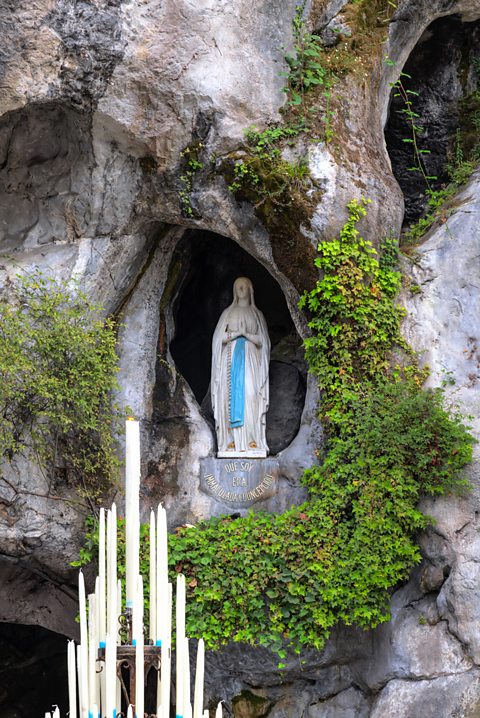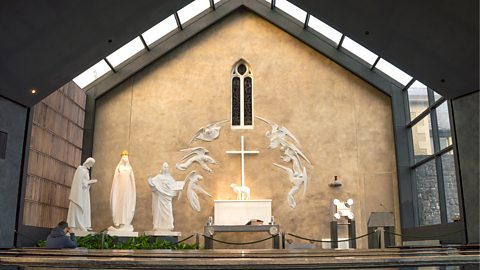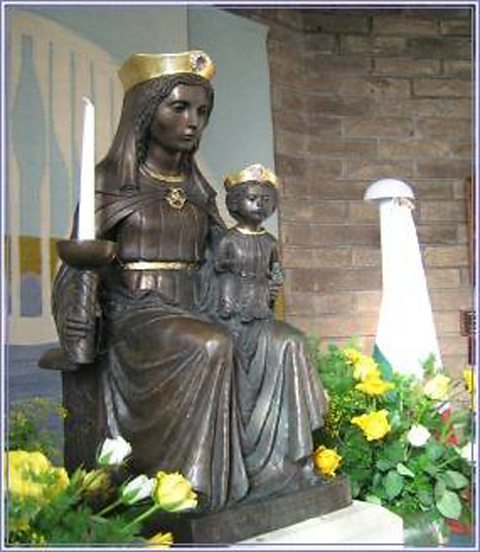Visions of Mary

The pilgrimageA journey which has religious or spiritual significance, usually to an important religious place. site of Lourdes is in France, near the Pyrenees mountains.
Every year, it is visited by millions of pilgrimA person who performs a journey which has religious or spiritual significance, known as a pilgrimage., particularly CatholicA group of Christians who accept the Pope in Rome as their leader.. They come to Lourdes to see the site of a famous vision experienced by a young girl called Bernadette Soubirous and to be healed by its supposedly miraculous waters.
Bernadette Soubirous was born in 1844 to a poor miller. One day, while collecting firewood, Bernadette is said to have seen Mary, the mother of Jesus, dressed in white with a blue sash and a yellow rose on each foot. Bernadette is said to have witnessed the same vision many times.
During one vision, the figure of Mary asked Bernadette to drink at the spring beneath her feet. Even though this area was muddy, the next day, the ground flowed with clear water. Bernadette was then told to have a chapel built in the exact spot where the vision had taken place.
Christian pilgrims now visit and pray in the Sanctuary of Our Lady of Lourdes and worship at the grottoA small cave. where the vision is said to have taken place.
Pilgrims also take part in a Torchlight Marian Procession which occurs every evening before a service of mass in the grotto. Pilgrims also confess their sins at the Reconciliation Chapel.
Knock
Knock is a village in County Mayo in the west of Ireland. On 21 August 1879, at 20:00, it was claimed that a small group of people saw a vision of three saints at the village church. The three saints were:
- Mary the Mother of Jesus
- St Joseph
- St John the Evangelist
There were 15 witnesses in total, and their testimonies all stated that they saw these three figures. At the time of the appearance it was raining, but the witnesses testified that the three saints remained dry at the time.

Marian Shrine of Wales

The National Marian Shrine of Wales in Cardigan, west Wales is the shrineTomb or monument to a saint or other holy person. of Our Lady of the Taper.
Legend has it that in the Middle Ages, a statue of Our Lady, with the baby Jesus on her lap and a burning taperA slim candle. in her hand appeared on the banks of the River Teifi. Any attempts made to move the statue to the local parish church resulted in the statue reappearing back at the river bank. This led to it becoming a place of pilgrimage, and St MaryŌĆÖs Church was built on that spot.
After the original statue was destroyed in the ReformationThe period in history when Protestants broke away from the Catholic Church., the current statue was installed in 1986. In the same year, Our Lady of the Taper became the Welsh National Shrine of Our Lady, as designated by Pope John Paul II.
Pilgrims visit the shrine to show their devotion to Mary and others to pray and ask Our Lady to intercedeTo intervene or make a request on behalf of someone else. for them.
Penrhys
Penrhys is a small village in the Rhondda Valley. The story of Penrhys goes back to the establishment of a monasteryThe building where monks live. at Llantarnam where, within the boundaries of the abbey, an image of Mary is said to have appeared in an oak tree.
According to legend, the image could not be removed from the tree until a shrine chapel was built on top of the Holy Well at Penrhys. The Holy Well at Penrhys was claimed to have been a source of healing for those who were sick, similar to Lourdes today.
The shrine chapel was destroyed during the reformation, and religious images and statues were burnt, as in other places across other areas of the UK.
Despite the destruction of the shrine, there are records of Catholics making the pilgrimage to the place of the original shrine. In 1953, a new statue was erected where the former chapel once stood.